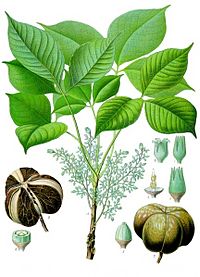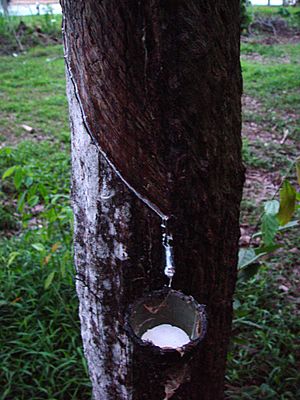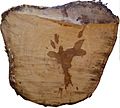Para rubber tree facts for kids
Quick facts for kids Rubber Tree |
|
|---|---|
 |
|
| Hevea brasiliensis | |
| Scientific classification | |
| Kingdom: | |
| Division: | |
| Class: | |
| Order: | |
| Family: | |
| Subfamily: | |
| Tribe: |
Micrandreae
|
| Subtribe: |
Heveinae
|
| Species: |
H. brasiliensis
|
| Binomial name | |
| Hevea brasiliensis Muell. Arg.
|
|
A Para rubber tree (or simply, rubber tree) is a special tree that naturally makes rubber. It comes from the tropical parts of South America, especially the Amazon area in Brazil. But, English farmers later spread it to countries in the Far East.
These trees belong to a plant family called Euphorbiaceae. In the wild, they can grow very tall, up to 100 to 125 feet (30-38 meters). They have large, straight trunks. Trees grown for rubber are usually about 20 inches (50 cm) wide.
When rubber trees are about 5 to 6 years old, they are ready to be harvested. Workers make small cuts in their trunks. This lets a milky liquid, called sap or latex, drip out. The sap is collected in small buckets. This process is known as rubber tapping. Older trees make more latex, but they stop producing it after about 26 to 30 years.
Contents
Growing Rubber Trees on Plantations
In the wild, a rubber tree can grow very tall, up to 140 feet (43 m). The white or yellow latex is found in special tubes inside the bark of the tree. These tubes spiral up the tree.
On rubber farms, the trees are usually smaller. This is for two main reasons. First, trees grow slower when they are tapped for latex. Second, trees are often cut down after about 30 years. This is because they produce less latex as they get older. After a certain age, it's not worth keeping them for rubber anymore.
Rubber trees need a warm, tropical or subtropical climate. They need at least 1,200 mm of rain each year. They also cannot handle frost. If it gets too cold and frosty, the rubber from a whole farm can become stiff and break easily.
How Latex is Collected (Tapping)
A natural rubber tree takes about seven to ten years before it can be harvested for the first time. Harvesters make careful cuts across the latex tubes in the bark. They cut just deep enough to get the latex without hurting the tree's growth. The milky latex then drips into small buckets. This method is called rubber tapping. The amount of latex a tree produces can be very different from one tree to another.
Harvesting Rubber Tree Wood
As rubber trees get older, they produce less latex. Because of this, most rubber trees are cut down when they are between 25 and 30 years old. In the past, these old trees were often burned. But now, their wood is often used to make furniture.
Images for kids
See also
 In Spanish: Árbol del caucho para niños
In Spanish: Árbol del caucho para niños







